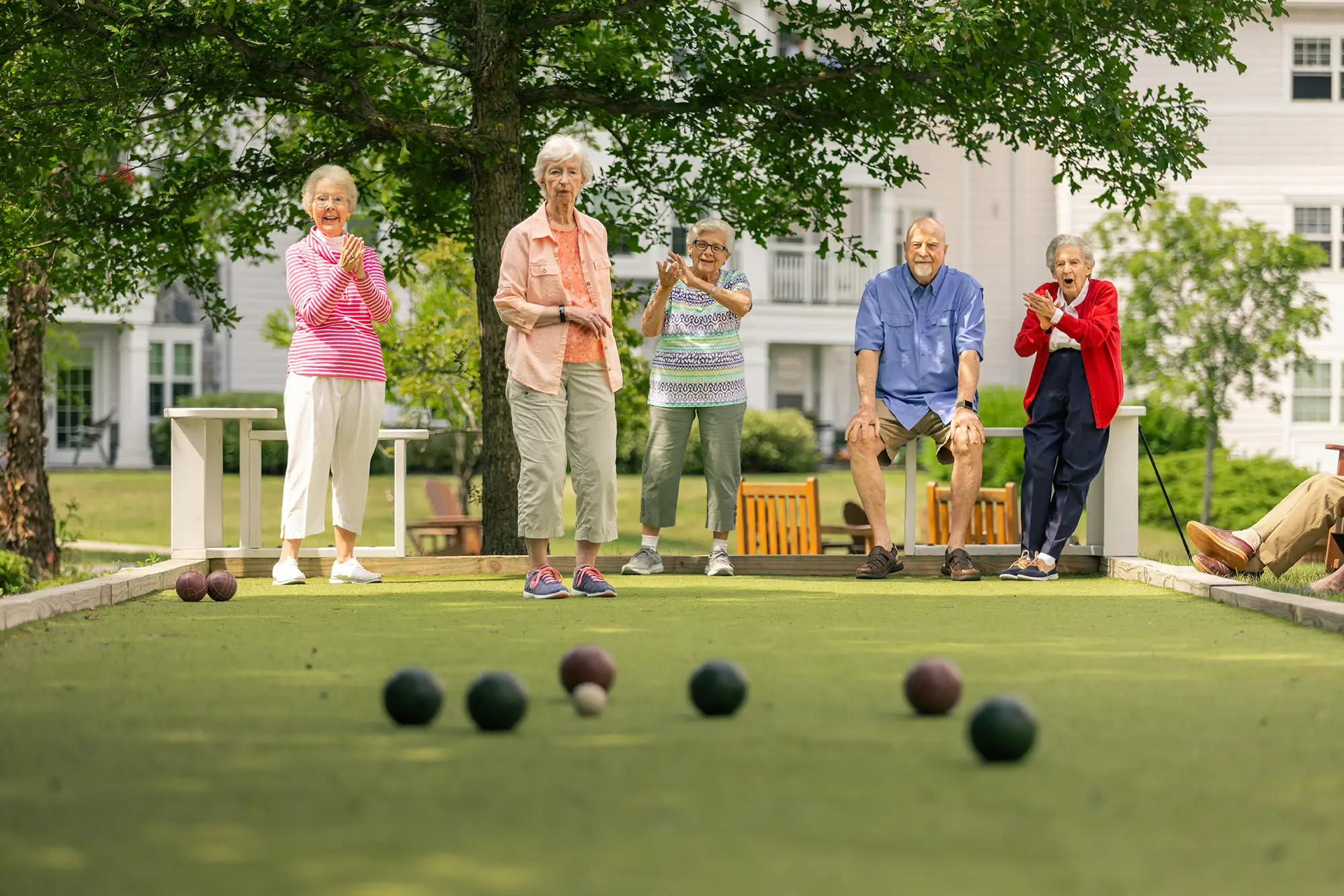
Contact
Rediscovering Your Stride: Exercises After Knee Replacement
Knee replacement surgery can open the door to a more active and fulfilling life. It’s a chance to say goodbye to pain and hello to renewed mobility. But like any journey, the road to recovery requires careful steps, especially when it comes to exercise.
In fact, according to the American Academy of Orthopaedic Surgeons, more than 850,000 knee replacements are performed each year in the U.S., with the majority of recipients being seniors.
With the right guidance and support, you can regain your strength, flexibility and confidence. This guide will walk you through starting your routine, exercises after knee replacement, and the benefits of physical therapy, empowering you to return to your daily routine as quickly as possible.
Safety First: Listening to Your Body
Your knee replacement recovery is a marathon, not a sprint. While exercise is crucial, it’s equally important to prioritize safety and listen to your body’s signals – especially the first weeks after surgery.
Key Principles:
- Avoid Pain: If an exercise causes pain, stop immediately and consult your physical therapist. Pain is your body’s way of telling you to slow down or modify the movement.
- Start Slowly: Begin with a low-intensity, short-duration exercise routine and gradually increase the frequency, intensity and duration as your knee heals and strength improves.
- Respect Your Limits: Don’t push yourself too hard, too fast. It’s OK to take breaks and rest when needed.
- Modify As Needed: If you have any limitations or concerns, your physical therapist can modify exercises to make them more manageable and safe for you.
Gradual Progression: Your Key to Sustainable Recovery
Gradual progression is the foundation upon which you’ll build strength, flexibility and confidence in your new knee joint. Here’s why it’s essential to your recovery after replacement:
- Prevents Injury: Pushing yourself too hard, too fast can strain your healing tissues and potentially set back your recovery. Gradual progression allows your body to adapt to increasing demands without risking reinjury.
- Optimizes Healing: Your body needs time to heal and rebuild strength after surgery. Gradually increasing the intensity and duration of your exercises gives your tissues the opportunity to repair and remodel, leading to a stronger, more resilient knee.
- Builds Confidence: As you gradually master new exercises and challenges, you’ll gain confidence in your abilities and feel empowered to continue your fitness journey.
- Ensures Long-Term Success: Gradual progression is not just about short-term recovery; it’s about setting the stage for a lifetime of active living. By building a solid foundation of strength and mobility, you’ll be better equipped to maintain your knee health and enjoy your favorite activities for years to come.
At StoneRidge’s Avalon Health Center, our physical therapists recognize that every recovery journey is unique. Whether you’ve undergone a partial or total knee replacement, they’ll tailor a gradual exercise program and short-term rehabilitation services that empower you to regain strength, mobility and confidence.
Click play to hear Mike’s story about his double-knee replacement recovery and how he regained his strength with the help of the therapy team at StoneRidge:
Regaining Strength and Flexibility: An Evolving Exercise Program
Your knee replacement recovery is a journey with distinct phases, each requiring a slightly different approach to exercise. Here’s a sample program to get started:
Phase 1: Early Recovery (Weeks 1-4)
Focus: Reducing swelling, restoring range of motion, and promoting circulation. Aim to exercise for 10 to 15 minutes, two to three times a day.
Sample Exercises:
- Ankle pumps: Lie on your back or sit in a chair. Point your toes up and down repeatedly, like you’re pumping a gas pedal.
- Heel slides: Lie on your back with your legs straight. Slowly bend your knee and slide your heel toward your buttock. Hold for a few seconds and then slowly slide your heel back down.
- Quad sets: Sit or lie with your leg straight. Tighten the muscles on the top of your thigh (quadriceps) and hold for five to 10 seconds.
- Straight leg raises: Lie on your back with one leg straight and the other bent. Tighten the muscles of the straight leg and lift it a few inches off the floor. Hold for five to 10 seconds and lower slowly.
Phase 2: Intermediate Recovery (Weeks 5-12)
Focus: Strengthen muscles and improve endurance to boost balance and coordination. Aim for 20 to 30 minutes of exercise, three to four times a week.
Sample Exercises:
- Standing knee bends: Stand facing a wall or sturdy chair for support. Slowly bend your knee as far as comfortable, then straighten it back up.
- Hamstring curls: Stand facing a wall or sturdy chair for support. Slowly bend your knee, bringing your heel toward your buttock. Hold for a few seconds and then slowly lower your foot back down.
- Step-ups: Stand facing a sturdy step or platform. Step up onto the platform with your operated leg, then bring your other leg up to meet it. Step back down, leading with the operated leg.
- Mini-squats: Stand with your feet shoulder-width apart, holding on to a sturdy chair or countertop for support. Slowly bend your knees as if you’re sitting down, then slowly straighten back up.
Phase 3: Advanced Recovery (Weeks 12+)
Focus: Regaining full function, returning to daily activities and hobbies. Try to reach at least 30 minutes of moderate-intensity exercise three to four days a week.
Sample Exercises:
- Walking: Start with short walks and gradually increase the distance and pace as your endurance improves.
- Stationary bike: A low-impact way to build cardiovascular fitness and leg strength.
- Aquatic exercises: The buoyancy of water reduces stress on your joints, making it an ideal environment for exercise.
- Low-impact aerobics: Classes like Zumba and chair Pilates designed specifically for seniors can provide a fun and social way to get fit.
Phase 4: Maintenance (Ongoing)
Focus: Maintaining strength, flexibility, and range of motion to support long-term knee health.
- Sample Exercises: Continue with a combination of exercises from Phase 3 after you fully recover, incorporating variety to prevent boredom and plateaus. Consider activities like pickleball, yoga, tai chi, or strength training with light weights.
Keep in mind that this is just a sample routine. Your actual plan should be tailored to your specific needs and abilities throughout your recovery.

Partnering With a Physical Therapist: Your Road Map to Recovery
A cornerstone of your knee replacement recovery is collaborating with a skilled physical therapist (PT). Think of your PT as your personal guide, tailoring a safe and effective exercise plan specifically for you. This personalized approach ensures that your exercises are not only appropriate for your current recovery stage but also align with your overall fitness level and health goals.
What To Expect From Your PT:
- Comprehensive Assessment: Your PT will assess your range of motion, strength and balance to create a baseline for your progress.
- Customized Exercise Plan: Based on their assessment, your PT will design a program that gradually progresses as your knee heals.
- Technique Guidance: Your PT will demonstrate proper form and technique for each exercise, ensuring you perform all exercises safely and effectively.
- Pain Management Strategies: Your PT can offer advice on managing pain and discomfort, utilizing techniques like ice, heat, or gentle stretches.
- Ongoing Support and Monitoring: They will track your progress, modify your plan as needed, and celebrate your achievements along the way.
Your Journey to Renewed Mobility Starts at StoneRidge
At StoneRidge, we recognize that the path to recovery after knee replacement surgery is as unique as the individuals who embark on it. Our commitment to personalized care means we tailor exercise plans, offer a range of options and modifications, and provide expert guidance from physical therapists who understand your needs.
But we offer more than just rehabilitation. We provide a vibrant, supportive community where you can connect with peers, participate in engaging exercise classes, and access the resources you need to achieve long-term knee health and rediscover the joys of an active lifestyle.
Your journey to renewed mobility doesn’t end with surgery – it begins with the right support. Schedule a personalized visit to learn how we can help you take those confident strides toward a healthier, happier you.





